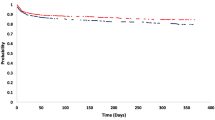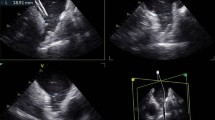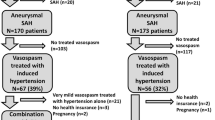Abstract
Objective
This study aimed to investigate the effectiveness of risk scoring for predicting stroke recurrence after percutaneous patent foramen ovale (PFO) closure or medication therapy in patients with PFO and a history of cryptogenic stroke.
Methods
This study included 559 patients with PFO and cryptogenic stroke who were treated in our hospital from January 2013 to January 2018 and were followed up for 15–72 months. After calculating the risk scores for stroke recurrence, we randomly divided the patients into two groups (ratio, 1:1): Patients in one group underwent PFO closure and those in the other received drug therapy.
Results
Patients in the PFO closure group had a lower risk of recurrent stroke than those in the drug therapy group (1.1% vs. 4.2%). Moreover, serious bleeding was less frequent in the PFO closure group than in the drug therapy group (0% vs. 3.2%), although the incidence of atrial fibrillation or flutter did not significantly differ between the groups (p = 0.67). Interestingly, a subgroup analysis revealed no inter-treatment group difference in the rate of cryptogenic stroke recurrence among patients with risk scores of 0–1. By contrast, PFO closure yielded superior outcomes among patients with risk scores of ≥2.
Conclusion
Compared with drug therapy, PFO closure reduced the risk of recurrent stroke among patients with a risk score of ≥2 and reduced the incidence of serious bleeding without increasing the risk of new-onset atrial fibrillation or atrial flutter.
Zusammenfassung
Ziel der Arbeit
Ziel der vorliegenden Studie war es, die Wirksamkeit der Risikobewertung zur Vorhersage eines Schlaganfallrezidivs zum einen nach perkutanem Verschluss eines offenen Foramen ovale (PFO) oder zum anderen unter medikamentöser Therapie bei Patienten mit PFO und einem kryptogenen Schlaganfall in der Anamnese zu untersuchen.
Methoden
In die Studie wurden 559 Patienten mit PFO und kryptogenem Schlaganfall einbezogen, die zwischen Januar 2013 und Januar 2018 in der Klinik der Autoren behandelt und deren Erkrankungsverlauf 15–72 Monate lang nachuntersucht wurde. Nach Ermittlung der Risikobewertung für ein Schlaganfallrezidiv unterteilten die Autoren die Patienten randomisiert in 2 Gruppen (im Verhältnis 1:1): Die Patienten in der einen Gruppe wurden mittels PFO-Verschluss und die in der anderen Gruppe medikamentös behandelt.
Ergebnisse
Die Patienten in der Gruppe mit PFO-Verschluss wiesen ein geringeres Risiko für ein Schlaganfallrezidiv auf als die in der Gruppe mit medikamentöser Therapie (1,1 vs. 4,2 %). Außerdem trat eine schwere Blutung seltener in der Gruppe mit PFO-Verschluss auf als in der Gruppe mit medikamentöser Therapie (0 vs. 3,2 %), obwohl die Inzidenz von Vorhofflimmern oder -flattern sich nicht signifikant zwischen den Gruppen unterschied (p = 0,67). Interessant war, dass eine Subgruppenanalyse keinen Unterschied zwischen den Behandlungsgruppen bei der Rezidivrate eines Schlaganfalls für Patienten mit Risikowerten von 0–1 ergab. Dagegen zeigten sich nach PFO-Verschluss überlegene Ergebnisse für Patienten mit Risikowerten von ≥2.
Schlussfolgerung
Im Vergleich mit medikamentöser Therapie reduzierten sich nach PFO-Verschluss einerseits das Risiko eines Schlaganfallrezidivs bei Patienten mit einem Risikowert von ≥2 und andererseits auch die Inzidenz schwerer Blutungen, ohne das Risiko für ein neu auftretendes Vorhofflimmern oder Vorhofflattern zu erhöhen.
Similar content being viewed by others
References
Cabanes L, Mas JL, Cohen A et al (1993) Atrial septal aneurysm and patent foramen ovale as risk factors for cryptogenic stroke in patients less than 55 years of age. A study using transesophageal echocardiography. Stroke 24:1865–1873
Handke M, Harloff A, Olschewski M et al (2007) Patent foramen ovale and cryptogenic stroke in older patients. N Engl J Med 357:2262–2268
Calvert PA, Rana BS, Kydd AC, Shapiro LM (2011) Patent foramen ovale: anatomy, outcomes, and closure. Nat Rev Cardiol 8:148–160
Furlan AJ, Reisman M, Massaro J et al (2012) Closure or drug therapy for cryptogenic stroke with patent foramen ovale. N Engl J Med 366:991–999
Meier B, Kalesan B, Mattle HP et al (2013) Percutaneous closure of patent foramen ovale in cryptogenic embolism. N Engl J Med 368:1083–1091
Nasir UB, Qureshi WT, Jogu H et al (2019) Updated meta-analysis of closure of patent foramen ovale versus drug therapy after cryptogenic stroke. Cardiovasc Revasc Med 20(3):187–193
Saver JL, Carroll JD, Thaler DE et al (2017) Long-term outcomes of patent foramen ovale closure or drug therapy after stroke. N Engl J Med 377:1022–1032
Lee PH, Song JK, Kim JS et al (2018) Cryptogenic stroke and high-risk patent foramen ovale: the DEFENSE-PFO trial. J Am Coll Cardiol 71:2335–2342
Chatterjee A, Hillegass WB (2018) Patent foramen ovale closure for cryptogenic stroke: effective, but only in select patients. Catheter Cardiovasc Interv 92(1):174–175
Frazin LJ (2007) Patent foramen ovale or pulmonary arteriovenous malformation: an appeal for diagnostic accuracy. Chest 132(1):5–6
Rigatelli G, Dellavvocata F, Braggion G et al (2008) Persistent venous valves correlate with increased shunt and multiple preceding cryptogenic embolic events in patients with patent foramen ovale: an intracardiac echocardiographic study. Catheter Cardiovasc Interv 72(7):973–976
Calvert PA, Rana BS, Kydd AC et al (2011) Patent foramen ovale: anatomy, outcomes and closure. Nat Rev Cardiol 8(3):148–160
Zhang YS, Zhu XY (2015) Chinese expert recommendations for patent foramen ovale treatment strategies. Chin Heart J 27(04):373–379
Jones WJ, Williams LS, Meschia J (2001) Validating the questionnaire for verifying stroke-free status (QVSFS) by neurological history and examination. Stroke 32:2232–2236
Schulman S, Kearon C (2005) Definition of major bleeding in clinical investigations of antihemostatic medicinal products in non-surgical patients. J Thromb Haemost 3(4):692–694
Mas JL, Derumeaux G, Guillon B et al (2017) Patent foramen ovale closure or anticoagulation vs. antiplatelets after stroke. N Engl J Med 377:1011–1021
Komar M, Podolec P, Przewlocki T et al (2012) Transesophageal echocardiography can help distinguish between patients with “symptomatic” and “asymptomatic” patent foramen ovale. Kardiol Pol 70(12):1258–1263
Serafini O, Misuraca G, Greco F et al (2003) Prevalence of structural abnormalities of the atrial septum and their association with recent ischamic stroke or transient ischamic attack: echocardiography evaluation in 18631 patients. Ital Heart J 4(1):39–45
Overell JR, Bone I, Lees KR et al (2000) Interatrial septal abnormalities and stroke: a meta-analysis of case-control studies. Neurology 55:1172–1179
Schuchlenz HW, Weihs W, Horner S et al (2000) The association between the diameter of a patent foramen ovale and the risk of embolic cerebrovascular events. Am J Med 109(6):456–462
Xu WH, Xing YQ, Yan ZR et al (2014) Cardiac right-to-left shunt subtypes in chinese patients with cryptogenic stroke: a multicenter case-control study. Eur J Neurol 21(3):525–528
Giblett JP, Abdul-Samad O, Shapiro LM et al (2019) Patent foramen ovale closure in 2019. Interv Cardiol 14(1):34–41
Hornung M, Bertog SC, Franke J et al (2013) Long-term results of a randomized trial comparing three different devices for percutaneous closure of a patent foramen ovale. Eur Heart J 34(43):3362–3369
Bronzetti G, D’Angelo C, Donti A et al (2011) Role of atrial fibrillation after transcatheter closure of patent foramen ovale in patients with or without cryptogenic stroke. Int J Cardiol 146(1):17–21
Funding
The study was funded by Health Commission of Sichuan Province: study of the risk stratification in the patients with patent foramen ovale and paradoxical embolism.
Author information
Authors and Affiliations
Contributions
Study design: Yunbing Liu; performed the experiments: Yi Wu and Lu Xiong; data acquisition and data analysis/interpretation: Yunbing Liu and Yi Wu; manuscript revision/review: Yunbing Liu. All authors agree to contribute to the journal Herz.
Corresponding author
Ethics declarations
Conflict of interest
Y. Liu,Y. Wu, and L. Xiong declare that they have no competing interests.
All procedures performed in studies involving human participants or on human tissue were in accordance with the ethical standards of the institutional and/or national research committee and with the 1975 Helsinki declaration and its later amendments or comparable ethical standards and was approved by the ethics committee of Mianyang Central Hospital. Informed consent was obtained from all individual participants included in the study.
Rights and permissions
About this article
Cite this article
Liu, Y., Wu, Y. & Xiong, L. Surgical vs. drug therapy in patients with patent foramen ovale and cryptogenic stroke. Herz 46, 250–254 (2021). https://doi.org/10.1007/s00059-020-04921-3
Received:
Revised:
Accepted:
Published:
Issue Date:
DOI: https://doi.org/10.1007/s00059-020-04921-3




